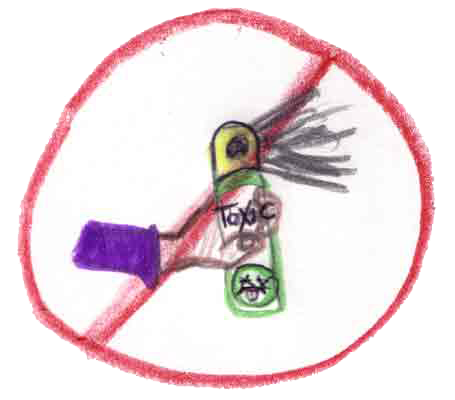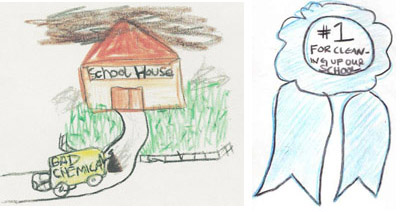Learn How We Can Make Our Schools Healthier
Investigated and written by Britta Svensson
Intern from the University of Minnesota
Every day kids all over the world are going to school.
It is very important that schools are a safe and healthy environment for kids of all ages.
By following these steps you can make your school healthier!
Step 1. Learn What Happened in Minnesota

Make sure your school is following the Right to Know about pesticides in your school law. In 1999 the state of Minnesota passed a law about the right to know when pesticides were sprayed in schools. Minnesota moms in MNCHEC, as well as other environmental activists, joined together to encourage their government leaders to pass this important law. Learn more about how they made this happen.
The law says that schools have to notify parents that they may have the option to know when their schools are being sprayed with pesticides. They can choose to keep their children home. Here’s more about the Janet Johnson Right to Know About Pesticides In Schools Law.
Here is additional information from the Minnesota Department of Health that will help you learn a lot about Children’s Environmental Health. And here you can learn about many School Environmental Health issues schools.
Step 2. Take Action
Talk to a state legislator and ask them for their help. Many states have already adopted new laws to make schools healthier. It’s easier than you think. You can do it too. Restricted spray zones, posting notifications, and spray regulations are all effective ways to clean up schools. Visit The University of Minnesota Extension IPM link to learn what is happening in Minnesota and you’ll see that you can make it happen in your state.
Step 3. Learn From Experience.
Britta Svensson called several schools in Minnesota to find out what they are doing to make their schools safe from pesticides and other toxicants. Here’s what she discovered:
Juan Lengthmen representing the Mounds School District informed me that all of their schools actively use Integrated Pest Management. He finds that for most problems pest traps will do the trick. None of the schools have recently had a serious problem with any pests, but he assured that under IPM pesticides would definitely be a last resort and used with tight control. Notifications are sent out on a yearly basis. This year homes received a notice on September 15th that addressed pesticide use so that parents could get answers to questions that they might have.
Hopkins School District is using organic products on schoolyards. They are working to prevent pests through Integrated Pest Management (IPM), instead of using chemicals to get rid of them.
Sandra Nolte from the Health and Safety Department for the Robbinsondale School District also answered “yes” to using integrated pest management. She explained that the notification process actually has become a system for their schools. Parents reply to a letter where they have the opportunity request being contacted when pesticides are going to be used in the school. This way when any school suddenly finds a need to use a pesticide, instead of needing to contact everyone, they can just pull from the database exactly which homes to contact. She also reiterated that under IPM, pesticides are not used often.
Minnetonka School District reported that they follow the guidelines of the MN Department of Agriculture when it comes to pest management and lawn care. Jim McCain explained that the basically just don’t use pesticides at all. They entrust the lawn care to Greener Pastures, and Plunkets Pest Control for monthly inspections. For more serious pests such as Bees, “Bee jars” work well to rid the winged insects at no health risk to staff or students sharing the airspace, once the nest has been removed. He also notes that Bees tend to be a problem outdoors, near the dumpsters and recycle bins which reduces the need for a harmful pesticide since most children aren’t in that area anyway. For rodents, Minnetonka schools stick to traps instead of poisons. Overall they don’t feel pests are a problem in their schools and find IPM works when the problems do arise.
Lincoln Elementary in St. Cloud, MN has made several changes to make their school healthier. This school now used IPM and has undertaken other projects to make the school healthier. From the limiting of animal pets in the classroom to educational purposes only, to changing floor covering, Lincoln has taken environmental health seriously. By replacing carpets found to carry high levels of mold with vinyl tile, (which is approximately the same cost as carpet, but lasts longer) the health of the staff in the school was significantly improved.
Our school was unhealthy, but now we have cleaned up our act!
Maple Grove Senior High (MGSH) got active after being encouraged by the “Right to Know” about pesticides in school act to learn more about the pesticides they were spraying in school and also of some cleaning products they had used. Since becoming more aware of the risks, MGSH has simply stopped using many products altogether. They found that they didn’t even really need them!
Benjamin Banneker School in Minneapolis switched cleaning and pest control products when the combination of the Right to Know act and teachers complaining of headaches brought them awareness. They report the teachers now feel much better!
Prior Lake School District didn’t have a lot of new information to share. The Operations Manager confirmed that the school district does send out a notice in their calendar about when applications, if any, will be used. He said, “We don’t use pesticides unless needed.”
St. Louis Park Schools prefer to send out letters when they find they need to, instead of instituting a set mail date. This way they don’t have to predict when problems could occur in which schools. Mary Schultz found success with pest control simply by making sure all doors are kept shut (and not propped for extended amounts of time). She also noted that making sure food, or food crumbs are not around the school because they of course support pests. All of the St. Louis Park schools are following Integrated Pest Management and find it is a reasonable program.
John Duetch with the Rosemont School District says that if a pesticide is needed in any of their schools “It must be a category 4.” Like the other schools, John said that pests don’t seem to be a huge problem. The worst is ants, but they are easily preventable. One way Rosemont schools prevents pests from entering the school is by having Orkin Pest Control do a monthly walk through to seal cracks. They also try to rid the food sources that may keep the pests alive. He felt that their schools were healthy and not threatened by pests or pesticides.
Step 4. Spread the word
Share what you have learned and done about creating healthier schools in your community with your friends, parents, and teachers. Tell them about this Kids for Saving Earth web site link. Beyond Pesticides and the Minnesota Department of Health continue educating the public about health risks, solutions, and new laws. Be sure to let everyone know how they can learn more through their websites. Beyond Pesticides, Children’s Environmental Health at the Minnesota Department of Health.
Help everyone to understand that the health of children is at risk because of toxic substances in our environment. Go to The Children’s Health Environmental Network website to learn about the toxins that surround you in your home as well as in schools. You will learn how to protect your family.

